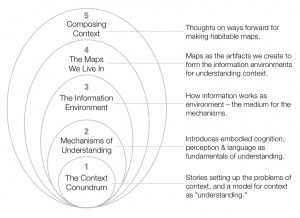I’ve been writing a book on designing context for about a year now. It’s been possibly the most challenging thing I’ve ever done.
I’m starting to see the end of the draft. It’s just beyond my carpal-tunnel-throbbing clutches. Of course, there are still many weeks of revision, review, and the rest still to go.
When I proposed the book to O’Reilly Media, I included an outline, as required. But I knew better than to post that outline anywhere, since I figured it would likely change as I wrote. It turns out, I was more right than I knew. So many of the hunches that nudged me into doing this work turned out to be a lot more complicated, but mostly in a good way.
One major discovery for me was how important the science around “embodied cognition” would be to sorting all this out; also, how little I actually knew about the subject. Now, I find myself fully won over by what some call the “Radical Embodied Cognition” school of thought. An overview of the main ideas can be found in a post at the Psych Science Notes blog, written by a couple of wonderful folks in the UK, from whom I’ve learned a great deal. (They also tweet via @PsychScientists)
At this point, I think the book has a fairly stable structure that’s emerged through writing it. There are 5 chapters; I have about 1/3 of the 4th chapter, and the 5th chapter, to go. (These shouldn’t take me nearly as long as the earlier stuff, for which I had to do a lot more research and learning.)
Partly to help explain this structure to myself, I came up with a diagram that shows how the points covered early on are revisited and built upon, layer by layer. (Touch/click to see full size in separate window)
Admittedly, the topics listed here don’t sound like a typical O’Reilly book; some might look at it and say “this is too theoretical, it’s not practical enough for me.” But, as I mention in the (still in draft) Preface, “there’s nothing more practical than understanding the properties of the materials you work with, and the principles behind how people live with the things you make.”
There will be “practical examples” of course, though perhaps not every 2-3 pages like in many UX-related books. (Nothing wrong with that, of course, it’s just not as appropriate for this subject matter.)
However — I’m still in the thick of writing, so who knows what could change? Now back to the manuscript. *typetypetypetype*



